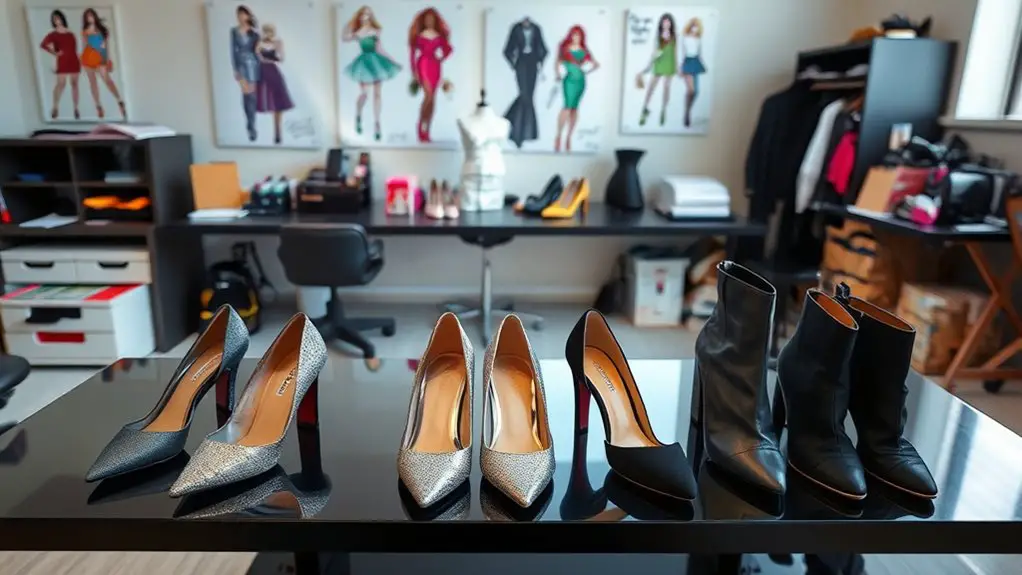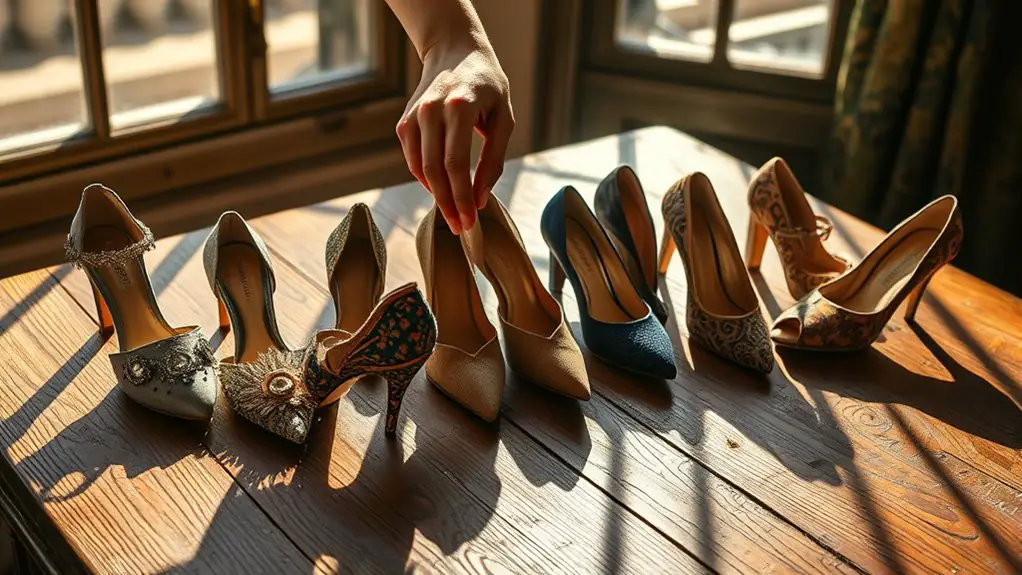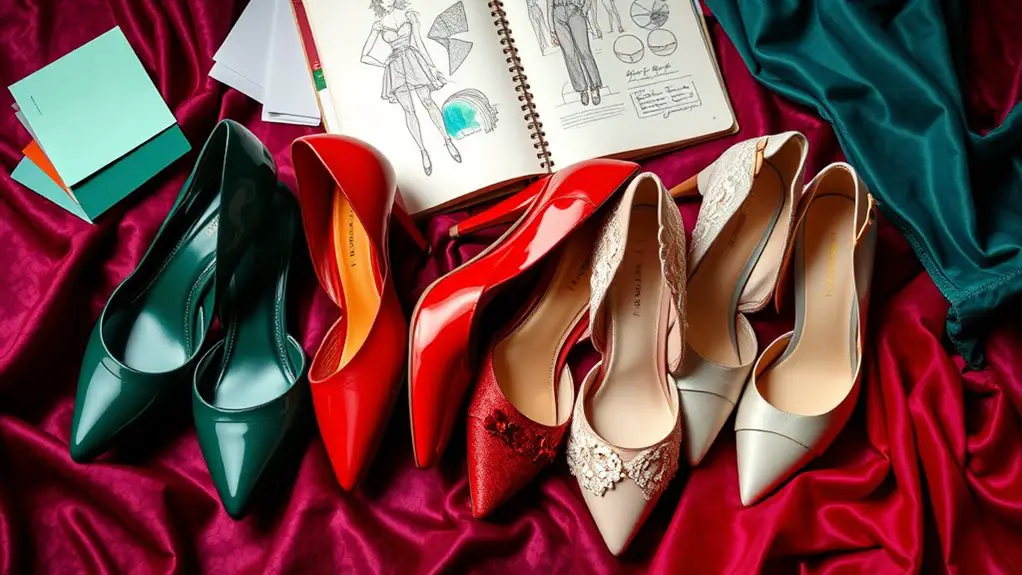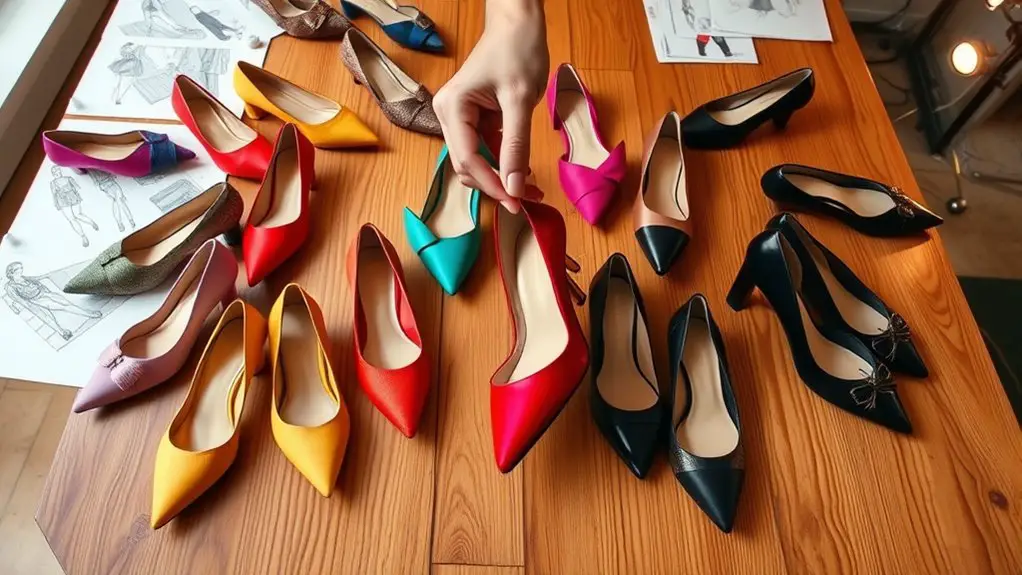Costume designers choose heels for female characters by considering their personality, emotional journey, and story context. They craft visual narratives that reflect power dynamics and identity. The right style can symbolize ambition, struggle, or transformation, and practicality is balanced with aesthetics for authentic performances. Historical and cultural influences also play a role in reflecting societal expectations. Curious about the collaborative process behind these choices? There’s so much more to explore.
The Impact of Footwear on Character Perception

When you think about a character’s footwear, it’s easy to overlook how much it can shape their perception. Picture a confident woman striding in sharp stilettos; those heels don’t just elevate her height, they also amplify her authority. You notice how the click-clack rhythm commands attention, altering your perception as she enters a room. On the other hand, a character in worn-out flats might evoke empathy, suggesting a backstory of struggle. Footwear symbolism runs deep—each choice whispers secrets about personality, status, and mood.
As a viewer or reader, you can’t help but feel those subtle shifts in perception. When a character shifts from sneakers to elegant heels, it signals transformation, a newfound sense of self. Every shoe tells a story, inviting you to explore the layers of identity woven into their fabric. So, next time you notice a character’s footwear, remember: it’s more than just style; it’s a narrative thread.
Balancing Aesthetics and Functionality
When you’re choosing heels for your character, think about how those shoes reflect her personality and the world she inhabits. Is she a daring adventurer who needs something sturdy for her escapades, or a glamorous socialite whose heels are as sharp as her wit? Balancing beauty and practicality isn’t just about aesthetics; it’s essential for crafting a believable and engaging story.
Character’s Personality Reflection
Although heels often symbolize elegance and allure, choosing the right pair for your female character goes beyond mere aesthetics; it’s about capturing her essence. Consider her character traits—does she exude confidence or fragility? A sharp stiletto might hint at ambition and power, while a chunky heel could signify a more grounded, playful nature. Footwear symbolism plays a significant role; each heel tells a story. You want those shoes to reflect her journey, her aspirations, and even her vulnerabilities. Think about the colors and styles that resonate with her personality. Are they bold and daring or soft and understated? The heels should not just complement her outfit—they should embody her spirit, weaving seamlessly into the narrative you’re crafting.
Scene Requirements Consideration
While you might envision your female character striding confidently in stunning heels, it’s essential to contemplate the scene’s demands. The right heel can elevate your character’s presence, but it must align with the scene dynamics and character movement. Consider these key factors:
- Action Intensity: Is your character running or simply walking? Heels need to match the action.
- Setting Terrain: Are they on a smooth surface or uneven ground? Stability matters!
- Emotional Tone: Does the scene call for elegance or urgency? Your choice of heel can subtly convey this.
- Character Development: How does the heel choice reflect your character’s journey?
Balancing aesthetics and functionality will guarantee your character captivates while maneuvering their world seamlessly.
Historical Context and Cultural Influences

As you explore the world of female characters, it’s vital to recognize how historical context and cultural influences shape the choices they make, including their footwear. Take a moment to reflect on how heels have evolved; they’re not just fashion statements but also carriers of cultural symbolism. In different eras, a character’s choice of heel can echo the societal expectations of femininity, power, or rebellion.
For instance, in the Victorian age, high heels symbolized status and decorum, whereas the flapper era embraced lower, more practical styles, reflecting women’s newfound independence. Each heel tells a story, rich with historical significance, offering insight into the character’s background and desires.
As a costume designer, you’re not just choosing shoes; you’re weaving together history, culture, and identity. The heels you select can reveal intricate layers of a character’s journey, making footwear an essential element of storytelling.
Character Arcs and Footwear Evolution
The evolution of a character’s footwear can mirror their personal journey, reflecting growth and change throughout the narrative. As you explore their story, notice how their heels transform, becoming a powerful symbol of their development.
- Initial Struggles: Characters often start in clunky, uncomfortable shoes, representing their challenges and insecurities.
- Emerging Confidence: As they gain strength, you might see them switch to stylish yet practical heels, showcasing newfound self-assurance.
- Defining Moments: A pivotal scene could feature bold, statement heels, symbolizing a major turning point in their character journey.
- Final Transformation: By the end, they may wear elegant, empowering footwear, signifying their ultimate growth and liberation.
These shifts in footwear not only enhance the visual storytelling but also deepen the audience’s connection to the character’s arc. Each pair of shoes tells a story, embodying the essence of who they’ve become.
The Role of Color and Material Choices

When choosing colors and materials for a character’s heels, consider how these elements can convey deeper emotional layers and personality traits. Think about color symbolism—red might exude passion and confidence, while soft pastels could suggest innocence or vulnerability. The hues you select can instantly communicate a character’s mood or intentions, setting the tone for their interactions.
Material durability is equally important. A sleek patent leather heel might signify ambition and sophistication, while a rugged suede could hint at a more adventurous or rebellious spirit. The choice between glossy or matte finishes can also reflect a character’s complexity; glossy suggests glamour, while matte might lean towards subtlety.
As you blend these choices, you’re not just dressing a character’s feet—you’re anchoring them within the narrative, ensuring that every step they take resonates with authenticity and intention. Each heel becomes a statement, revealing the layers of who they are in their journey.
Collaborating With Directors and Actors
When you sit down with directors and actors, it’s all about weaving character development into every stitch of those heels. You’ll explore how visual aesthetics can transform the narrative, while also balancing the tricky dance between comfort and style. Each choice you make not only supports the character but also brings the entire vision to life on stage or screen.
Understanding Character Development
Collaboration in character development breathes life into the narrative, weaving together the visions of directors, actors, and costume designers. Understanding character motivations and their emotional journeys is essential in selecting the perfect heels. Here’s how you can deepen that collaboration:
- Character Analysis: Immerse yourself in the backstory to grasp who your character really is.
- Director’s Vision: Discuss how the heels fit into the overall aesthetic and message of the film.
- Actor Input: Listen to the actor’s perspective on their character’s physicality and comfort.
- Story Arc: Consider how the heels evolve with the character—reflecting growth or change throughout the narrative.
Exploring Visual Aesthetics
The visual aesthetics of a film hinge on the seamless partnership between directors, actors, and costume designers. You’ll find that collaboration is key to translating a character’s essence through their heels. As you discuss visual symbolism with the director, you’ll uncover how specific styles can evoke emotions or signify status, shaping audience perceptions. Aesthetic trends play an essential role too; staying attuned to current styles guarantees the character resonates with viewers while remaining authentic. Picture a fierce protagonist striding confidently in chic stilettos, their height amplifying power dynamics in a scene. Meanwhile, the actor’s input brings life to the design, guaranteeing that each step they take embodies the character’s journey. Together, you create an unforgettable visual tapestry.
Balancing Comfort and Style
Although style often steals the spotlight, comfort shouldn’t be an afterthought when selecting heels for your female characters. You’ll find that balancing comfort vs. style is essential for a believable performance. Collaborating with directors and actors can illuminate practical considerations that enhance both aesthetics and comfort. Here are four key aspects to think about:
- Character’s Role: Consider how active or sedentary their role is; this can influence heel height and design.
- Scene Duration: Longer scenes might require more comfortable options to keep the actor focused.
- Setting: Think about the environment—walking on cobblestones demands sturdier heels.
- Actor’s Preference: Open a dialogue with your actors; their comfort can translate into a more authentic portrayal.
Iconic Heels in Film and Television
When you think of iconic heels in film and television, a few standout pairs likely come to mind, each telling a story as vivid as the characters who wear them. Picture Carrie Bradshaw strutting through Manhattan in her sky-high Manolos, creating unforgettable, heart-fluttering moments that encapsulate romance and independence. Then there’s Dorothy’s sparkling red pumps, which don’t just transport her home but also symbolize the journey of self-discovery.
These iconic styles are more than just footwear; they elevate the narrative, capturing the essence of powerful female characters. Think of the fierce stilettos worn by femme fatales, exuding confidence and allure, or the chic ankle boots of a spirited heroine, showcasing her rebellious nature. Each pair contributes to memorable moments, leaving an indelible mark on pop culture. You can’t help but remember these shoes, as they walk hand-in-hand with the stories that define them.
Challenges in Designing for Diverse Characters
While iconic heels often embody specific narratives, the challenge arises when designing footwear for a diverse range of characters. You’re not just creating shoes; you’re crafting a visual story that honors cultural representation and embraces inclusive design.
Consider these challenges:
- Cultural Significance: Different cultures have unique footwear traditions. You must respect these while maintaining character authenticity.
- Character Identity: Heels should reflect the character’s personality and backstory, which may vary dramatically.
- Practicality vs. Aesthetics: Striking a balance between stylish shoes and the character’s environment is essential; they need to be functional.
- Audience Expectations: Audiences often have preconceived notions about how characters should look, adding pressure to conform without losing individuality.
Navigating these elements can be tricky, but it’s what makes the design process so rewarding. After all, every heel tells a story.
Frequently Asked Questions
How Do Costume Designers Source Unique Heel Designs?
When you’re on the hunt for unique heel designs, vintage sourcing can feel like treasure hunting. Combine that with custom designs, and you’ll uncover a world where every step tells a story, just waiting to be worn.
What Budget Constraints Affect Heel Selections for Productions?
When you’re faced with budget limitations, production costs can dictate your choices. You’ll weigh style against price, searching for heels that not only fit the character but also keep the budget intact, ensuring creativity thrives.
Are There Specific Brands Frequently Used in Costume Design?
When it comes to costume design, you’ll find luxury brands often steal the spotlight, while vintage styles serve as a charming backdrop. Designers mix and match, ensuring every character walks a fine line of authenticity and flair.
How Do Seasons Impact Heel Choices for Characters?
Seasonal trends can transform a character’s journey; as you explore, you’ll notice how spring’s vibrant heels reflect blossoming growth, while winter’s sturdy styles underscore resilience. Each choice deepens character development, adding layers to their story.
What Role Does Audience Feedback Play in Heel Design Decisions?
Audience feedback shapes heel design considerably; it influences how you perceive a character’s alignment with their role. Designers often adjust styles based on this feedback, ensuring heels resonate with viewers’ expectations and enhance the character’s narrative.

